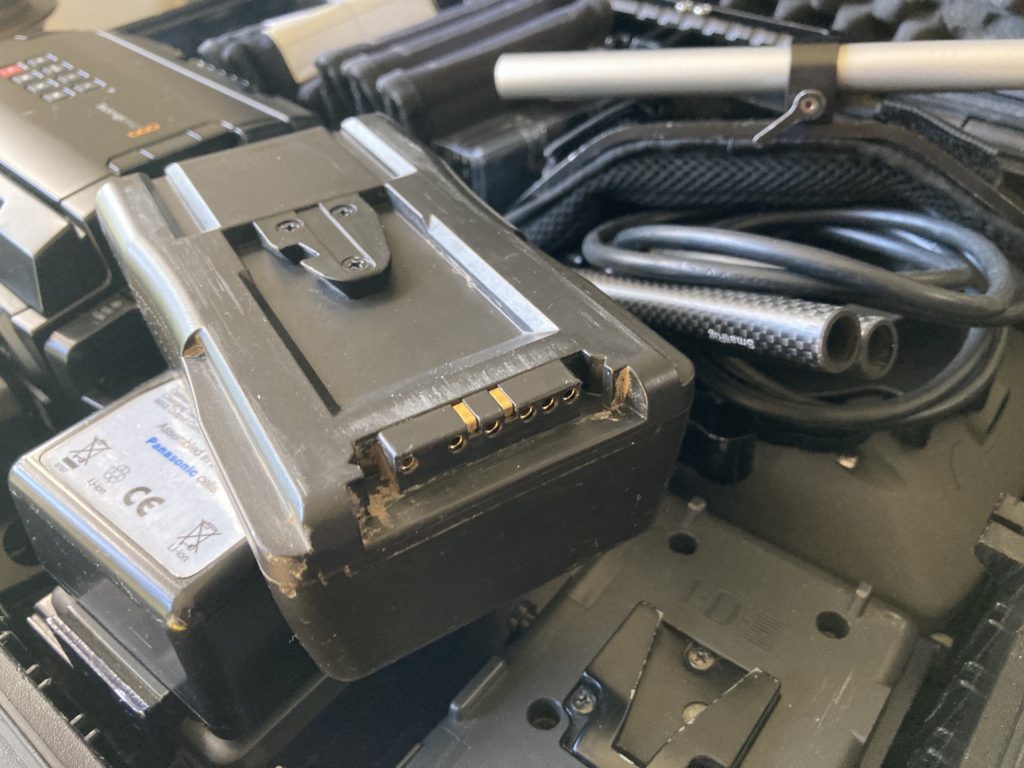If you work in film, or you’ve at least told people you want to work in film, then the chances are pretty high that someone has asked you about myriad job titles they’ve seen during some end credits.
The most common questions are about Grips, or Best Boys, or maybe they want to know the difference between an Assistant Director and a Director’s Assistant, but one that seems to leave people flummoxed when I talk about film is the “AC” a.k.a Camera Assistant (or, depending on the shoot-size, the 1st AC and the 2nd AC). But if you want to work in the camera department, you should probably brush-up on this knowledge post-haste.
So let’s take a look at the lowly 2nd AC, also known as the Clapper Loader, also known as 2nd Camera Assistant, also known as ‘the one doing the clapping thing’.
A quick disclaimer: To be honest, in this dystopian digital domain in which we now live, there are plenty of job titles in end credits even I don’t understand. Have you ever read the post-production credits on Marvel films? Blimey.
Power Struggle
To talk about the 2nd AC it would probably be helpful to look at the hierarchy of the camera department. Not only will it give a good overview, but it will also allow me to explain some acronyms straight away so that my job gets easier the longer this article continues. Some call is laziness, but I call it efficiency.

Every department has a HoD, or Head of Department, and in the case of the camera department this title is bestowed upon the DoP, otherwise known as the Director of Photography, the Cinematographer, the DP or, judging by the amount of film sets where this seems to be the case, that old guy with the white hair. They’re the ‘eyes’ of the production and will be creating the look of the film via the choice of cameras, lenses, angles, filters and more.
Depending on the size of the shoot, you might also have a separate Camera Operator, the person who physically operates the camera during a particular shot, or a Steadicam Operator, the person who uses a stabilizing unit for the camera, enabling smooth shots during movement. However, on smaller shoots, the DoP may operate the camera themselves.
Next in line is the 1st AC, who might also go by the name Focus Puller or 1st Assistant Camera. Their job is to ensure the camera is in focus and stays in focus when the subject, or the camera, moves during the course of the shot. But there’s much more to their job than that, which is why the name 1st AC is more commonly used these days. In many ways, I’ve always thought of a 1st AC as a Head of Department in all but name as anyone starting out in the camera department will probably answer to them.

Next we have the 2nd AC, whom we are discussing in this very article, so I won’t spoil too much right here. But suffice to say they are also known as the Clapper Loader or 2nd Assistant Camera, and will usually be seen on set operating the ‘clapper’ or ‘slate’, an object that has a very important use on a film set. They’re also in charge of loading the camera with film (or data cards in the modern day), camera batteries, and helping the 1st AC with their focusing, to name but a few responsibilities.
Then there is the Camera Trainee, the person who wants to rise through the ranks and learn everything camera. But whilst the name might suggest they help with everything, a Camera Trainee actually has defined responsibilities and these usually revolve around the Director’s Monitor, the television that is provided for the Director (and others) to observe rushes as they are filmed.
Some shoots might have more roles and the Camera Department will also work closely with the Grip and Electrical Department to achieve their goals (indeed, those departments will answer to the Director of Photography as well), but these are the core members of the team.
So are you ready to delve into the world of the 2nd AC? You better be, because here it comes:
The Clapper

You’ve seen a clapper before. It’s also known as a slate and no film shoot actually looks like a film shoot unless someone is using them. They have become an iconic part of a film set and everyone would recognise one if they found it lying around in the street (don’t ask me why it would be lying in the street; just go with it).
But what does it actually do? The clapper can serve a number of functions, but primarily it is used to both identify the shot (which is why it contains information like the shot number, scene, date etc.) and to help to synchronise the footage with the sound file (in case you didn’t know, sound is usually recorded separately).
At the beginning of a take, the AD (or Assistant Director) will usually announce ‘turnover’. The 2nd AC will then place the clapper in front of the camera (the distance from the camera is determined by the lens in use), after which you will usually hear the sound operator say ‘sound recording’ and then you’ll hear the camera operator or 1st AC say ‘speed’. The 2nd AC will then announce the slate or shot number followed by the take number. The 1st AC will then tell the 2nd AC when they can ‘mark it’. This is the point in which they close the hinged stick attached to the top of the clapper, creating the clapping noise used to sync the sound in post production.
Loading

As the 2nd AC is also known as the Clapper Loader, you might now be wondering what the ‘loading’ aspect requires. In the digital age this is somewhat of a dated term as it refers to the physical act of loading and unloading of film stock, which today has been replaced by the much simpler task of inserting and retrieving data cards. 2nd ACs have a system in changing these around so that they are properly labelled and processed by the DIT (Digital Imaging Technician).
Usually they will use a labelling system beginning with the roll number A001 and progressing upwards through A002, A003 etc. The ‘A’ denotes the camera (if there is only one camera this will still be labelled the ‘A’ camera and any others added to the roster will continue as ‘B’ cam, ‘C’ cam and beyond, all with their own dedicated teams…in an ideal world).
When a new card is inserted into the camera, the 2nd AC will usually write its roll number on a piece of coloured tape and attach it to the camera. When it is subsequently removed from the camera, this tape will be transferred to the card and handed to the DIT. Whilst this card is in use, its roll number will also be labelled on the clapper/slate.
Batteries

If the 2nd AC is lucky enough to have a Camera Trainee in the team, they will usually take care of batteries as well, but if not then the task falls upon the 2nd AC. No matter where the film shoot is taking place, batteries will always be charging and I’ve never met a good 2nd AC who feels comfortable unless a battery charging station has been established.
These batteries will include small camera batteries, large camera block batteries and anything else that requires power in the camera department. This could include batteries for a radio-controlled focus puling device for the 1st AC, the director’s monitor and, if they are in use, steadicam batteries.
Whether you are filming in a studio or in a field at 4 in the morning, a battery charging station is vital to ensuring filming is never interrupted. If there are no buildings with electricity, you’d better hope that Production has splashed out for a generator. I’ve worked on sets where a battery charging station has not been possible and, trust me, it is a strange and stressful environment in which to work. Not only are you fighting the weather and a tight schedule, but you are also dreading the fateful moment that shooting has to stop altogether… and guess who gets the blame in that scenario.
Focus Marks
We’ve established that the 1st AC is the Focus Puller, but the 2nd AC also plays a part in ensuring that this runs smoothly.

During the blocking stage the 1st AC will be setting focus marks so that they know where to turn their focus ring during the progression of the take. But to ensure this works every time the actor will also need to move to the correct locations. There’s no point in setting a focus mark on the camera if the actor is going to stand 10 feet away from the place they rehearsed!
So the 2nd AC will be responsible for ensuring the actor hits the right marks. As the DoP, the director and the actors are blocking, the 2nd AC will throw down coloured ‘sausages’ anywhere that they are required – with specific colours associated with specific actors – and they replace them with tape when they are finalised. Then it’s up to the actor to hit those locations whenever they run the scene.
Of course, a good 1st AC will be able to keep an actor in focus no matter where they move throughout the set, but focus marks make the job a lot easier. They also ensure that actors occupy the correct space in the frame and that the DoPs carefully choreographed frame is realised.
Lenses

I don’t need to tell you what a camera lens is, but I do need to tell you to look after them. If you’re a 2nd AC you’ll be hauling them around in a metal flight case keeping them safe and secure. They’re expensive, so you’ll be guarding them with your life, and if you drop one you’ll feel terrible. Over the years I’ve seen many people drinking from mugs shaped like realistic camera lenses and people love to play a joke on you by throwing them your way and giving everyone a heart attack. So, suffice to say, we take them seriously.
During the course of the shooting day, the DoP will wish to change lenses regularly and, when they do, it’s up to you to deliver that lens to the 1st AC so that they can change it. You’ll probably even make a note of it so that you can update your camera logs. (We‘ll be covering those in more detail in a upcoming article)
Everything else

These aren’t the only responsibilities of the 2nd AC during a film shoot. Every film is different and a good AC will be able to adapt to any situation.
A 2nd AC will always be on their feet, ensuring that the camera department is running smoothly, checking that equipment is clean and tidy and ensuring that everyone else in their department has what they need to do their jobs.
So now you should have a good idea of what a 2nd AC does whilst on set. From assisting the rest of the camera team to carrying out their own responsibilities, plus everything else in between, it is a job that requires care and attention. It is a demanding position, but highly rewarding when a shoot goes well and when you know that you have made for a pleasant working environment.
Just make sure you don’t drop any lenses. Oh, and look out for a future article that goes into more detail on preparing and using the slate/clapper.
